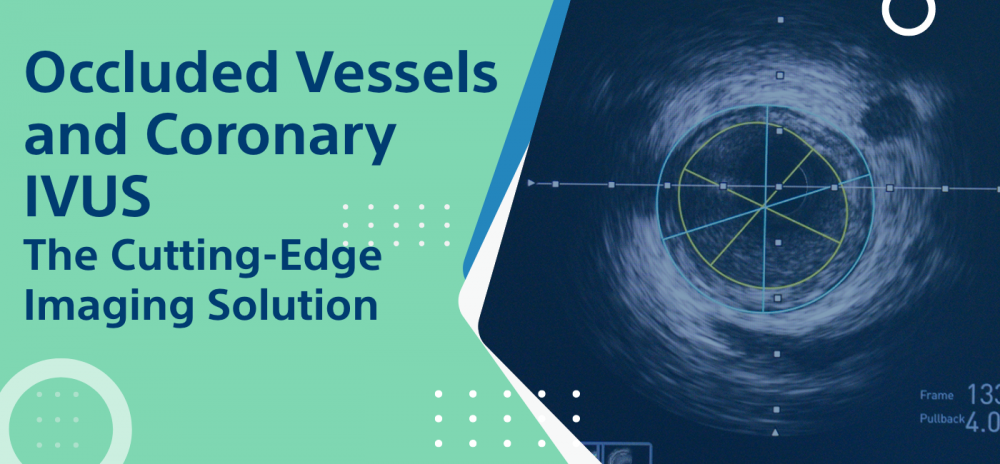Understanding and handling occluded vessels is critical in the specialty of cardiology. Such conditions bring severe effects on heart functions, and sometimes it leads to severe complications like heart attacks and other cardiovascular diseases. Recent developments in imaging technology, particularly coronary intravascular ultrasound, have shifted the patterns of diagnosis followed by cardiologists when treating patients with occluded vessels. This paper presents a discussion on what is meant by occluded vessels and its significance to coronary IVUS as an emerging solution in modern imaging.
Understanding Occluded Vessels
Occluded vessels are the state whereby the vessels are narrowed or obstructed due to several causes. The primary causes for this state are atherosclerosis, thrombosis, and embolism. Atherosclerosis is one of the forms of vascular disorders in which plaques start building up inside the arterial walls, and many people suffer from CAD due to this. These narrowed sections of the blood vessels restrict the flow of blood toward the heart muscle, thus leading to angina (chest pain) or even more severe heart attacks.
Vessel occlusion symptoms may be surprisingly diverse and extend from mild to even severe pain, sometimes life-threatening. Patients with occluded vessels may present with symptoms such as fatigue, shortness of breath, or other manifestations of impaired functions of the heart. The recognition of these symptoms early on becomes essential for timely intervention and therapy.
Overview of Coronary Intravascular Ultrasound (IVUS)
Coronary IVUS is one of the advanced imaging technologies that, with ultrasonic technology, capture images of the coronary arteries. This contrasts with the traditional angiography that only provides a view of blood vessels two-dimensionally; IVUS establishes a cross-sectional view that allows for more complete evaluation of the state of the arteries.
The importance of coronary IVUS lies in the description not only of the lumen – the inner space of the artery-but also of the surrounding vessel wall and plaque composition. Such an amount of detail is rather important for diagnostics and management of occluded vessels.
The Role of IVUS in Assessing Occluded Vessels
Coronary IVUS is particularly important in the evaluation of occluded vessels. IVUS allows cardiologists to visualize and evaluate the level and type of occlusions based on high-resolution images. Therefore, clinicians can determine the nature of the plaque, the degree of stenosis (narrowing), and complications such as thrombosis.
This is very helpful in deciding what type of treatment to apply. For instance, if a patient has occluded vessels, information that IVUS achieves will help determine whether to go on with angioplasty or stenting.
Advantages of IVUS in Evaluating Occluded Vessels
The benefits of IVUS in the evaluation of occluded vessels are:
High-Resolution Images: IVUS provides a real-time and cross-sectional view of the arteries, thereby unmasking complex structures that conventional imaging may not reveal.
Assessment of Composition of Plaque: The nature of the plaque can be understood to estimate the chances of its rupture and occlusion thereafter.
Guidance in Intervention: IVUS helps in guiding intervention procedures so that stents are deployed as precisely as possible, and immediate results can be accurately evaluated.
Techniques and Technology Behind IVUS
As for the technology itself concerning coronary IVUS, it is indeed one that has undergone a lot of advancement over the years. It basically entails a process where a very small catheter emitting ultrasound guided by a catheter through the guiding catheter is inserted into the coronary artery. The actual sound waves are emitted from this catheter and bounced back from the arterial walls, creating very detailed images.
The new IVUS systems work by using high-frequency transducers, which have enhanced the quality and resolution of the images. Real-time imaging now provides clinicians with immediate vision, enabling them to make direct decisions at the bedside and therefore increasing the safety as well as the efficacy of interventions for occluded vessels.
Clinical Applications of IVUS in Cardiology
Coronary IVUS has many varied clinical applications. Most appropriate is during the guidance of interventional procedures, such as angioplasty and stent placement. It makes possible the assessment and adjustment in real-time conditions for optimal results.
Apart from that, IVUS is used as a ruling tool in the study and enlightenment of atherosclerosis. With the penetration into the plaque formation and progress, a researcher can gain better knowledge and insights into the mechanisms that are involved in occluded vessels. It is through this that suitable therapies can be designed.
Comparative Effectiveness of IVUS vs. Other Imaging Techniques
In the management of occluded vessels, a discussion regarding the relative utility of IVUS in comparison to other imaging modalities is warranted. Traditional angiography is commonly used but fails to describe the vessel wall or plaque composition. High-resolution images from OCT lack the depth of penetration seen in IVUS.
Coronary IVUS would be important in complex cases, as here a deep understanding of the characteristic plaque and vessel morphology is very critical. For example, when calcified lesions are heavy in patients, so much information is derived that guides the decision of treatment.
Challenges and Limitations of IVUS
Although coronary IVUS has many advantages, challenges and limitations are noted. Operator dependency is the main concern from the ivus/IVUS; the quality of the images obtained depends on the skill and experience of the clinician performing the procedure.
This may not be the same for all patients. In some cases, if the arteries have a lot of twisting, it is relatively difficult to obtain clear images. Some patients also feel uncomfortable having the procedure.
Future Trends in IVUS Technology
The future of coronary IVUS holds much promise since new technologies such as fusion imaging are currently being developed to improve IVUS capabilities. Fusion imaging puts together data from IVUS with that of other imaging modalities; therefore, it gives a much better-integrated view of the cardiovascular system.
Active research is going on in the third area about 3D imaging. A 3D reconstruction of coronary arteries might provide clinicians with a better understanding of the spatial relations between occluded vessels and other structures surrounding them.
Conclusion
Occluded vessels pose significant challenges in cardiology; however, the introduction of imaging technology coronary IVUS in the diagnosis and treatment of these conditions has transformed the approach taken in the diagnosis of these diseases. This method allows one to visualize fine details regarding coronary arteries, allowing clinical decisions that will improve the outcome of the patient’s disease process.
Coronary IVUS has a very serious role, because it decides the interventional practices, at the same time, contributes to the venture of research and is involved in a better understanding of atherosclerosis and cardiovascular health. IVUS has a growing vital role in occluded vessel management, which positively increases the quality of care provided to the patients.



